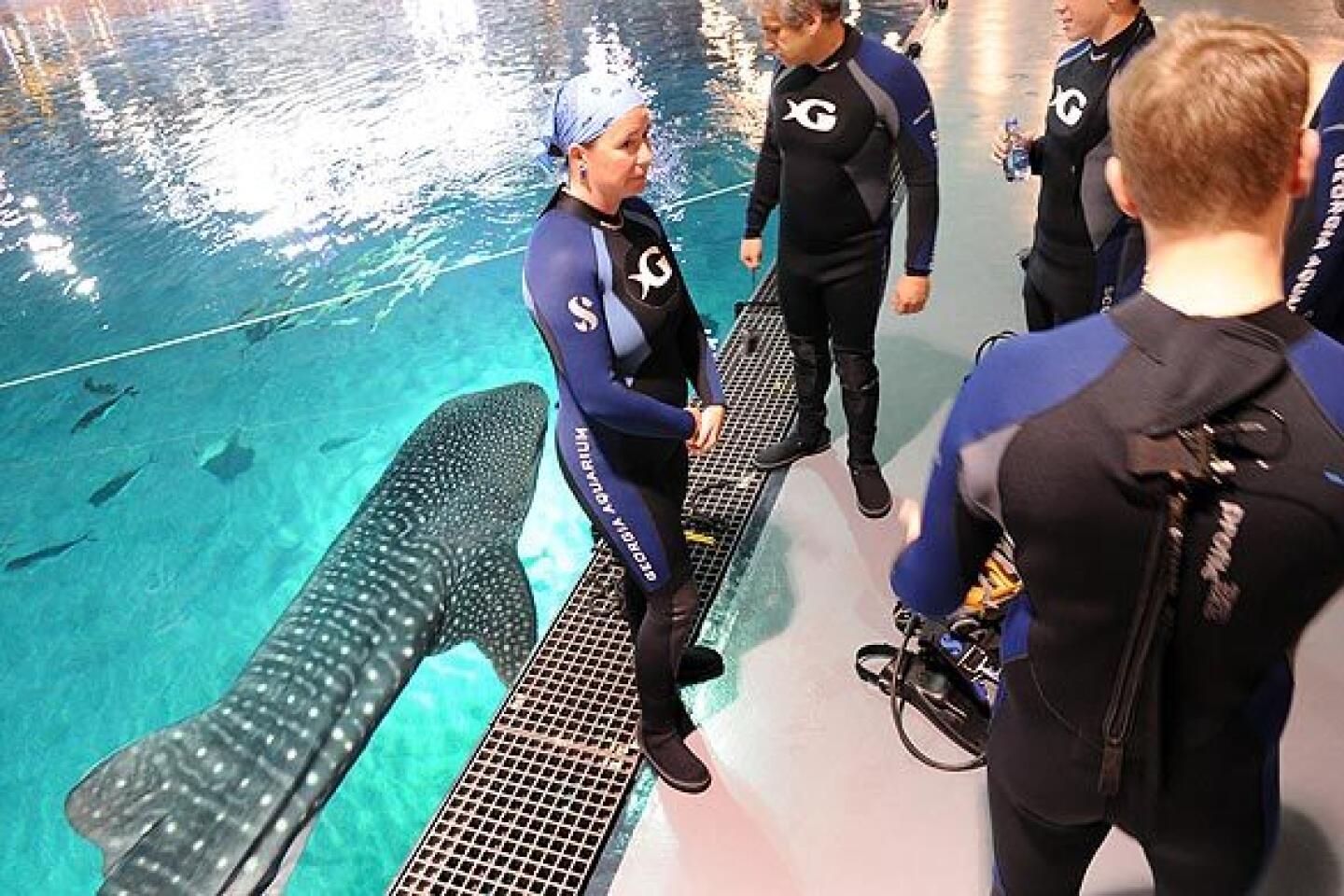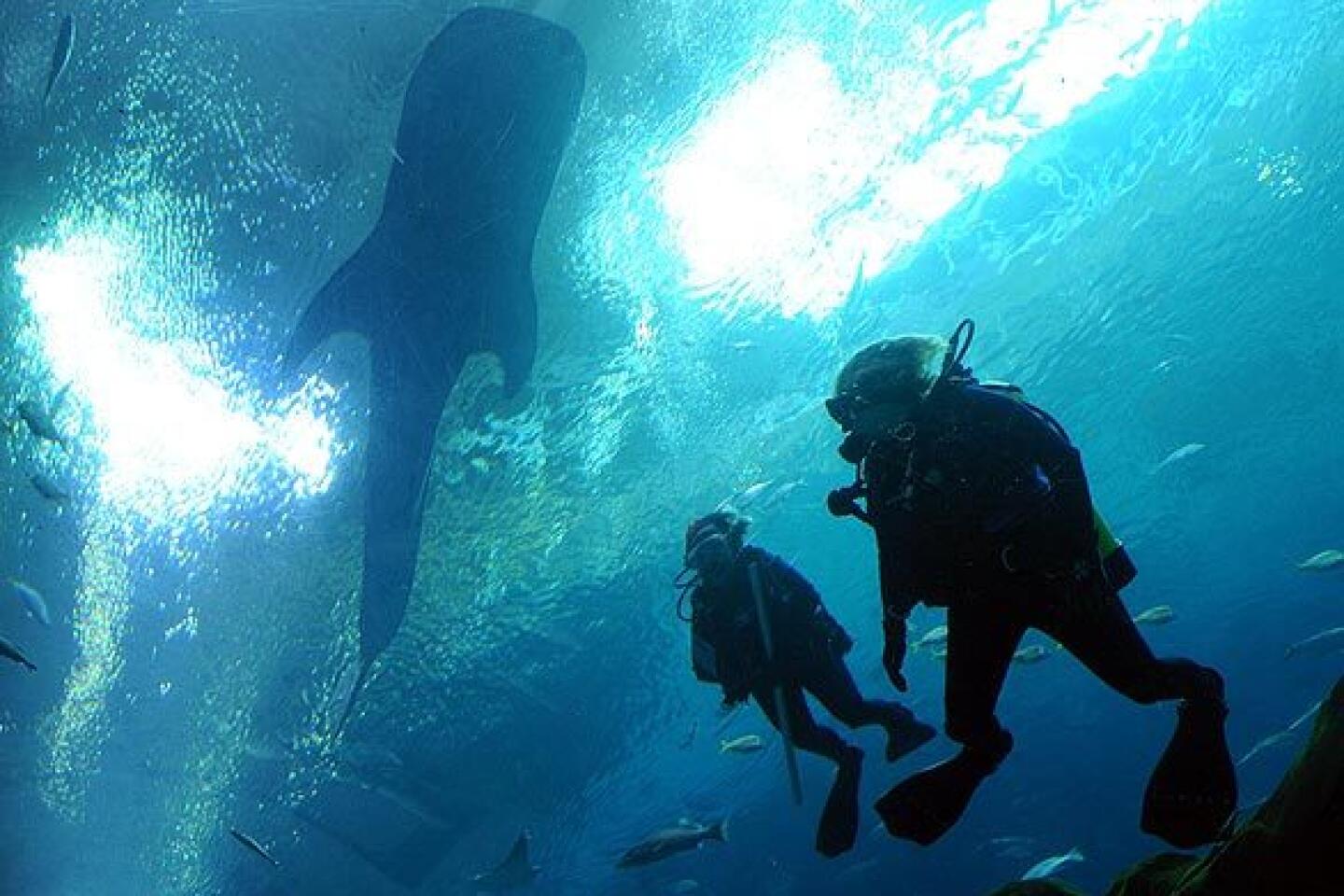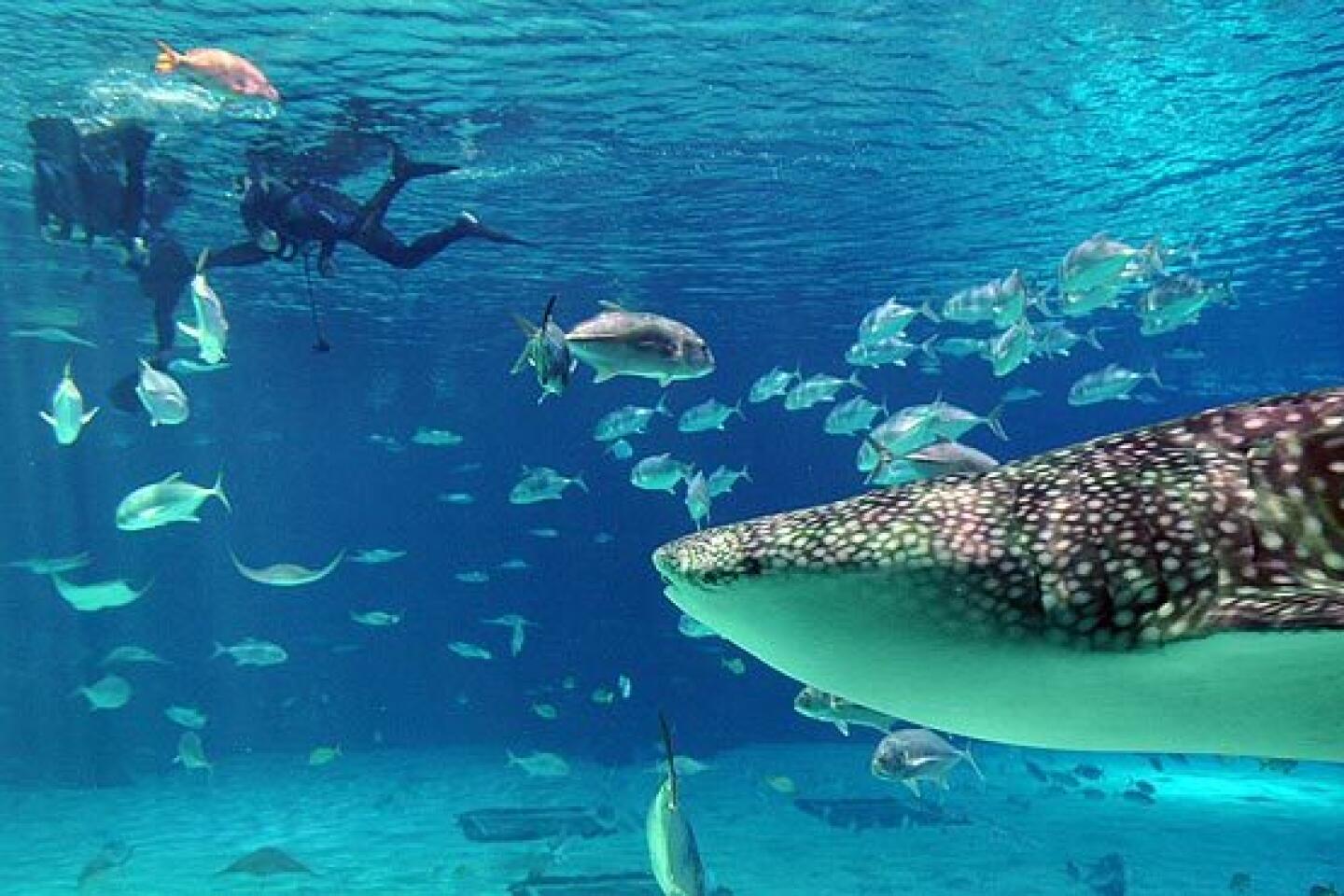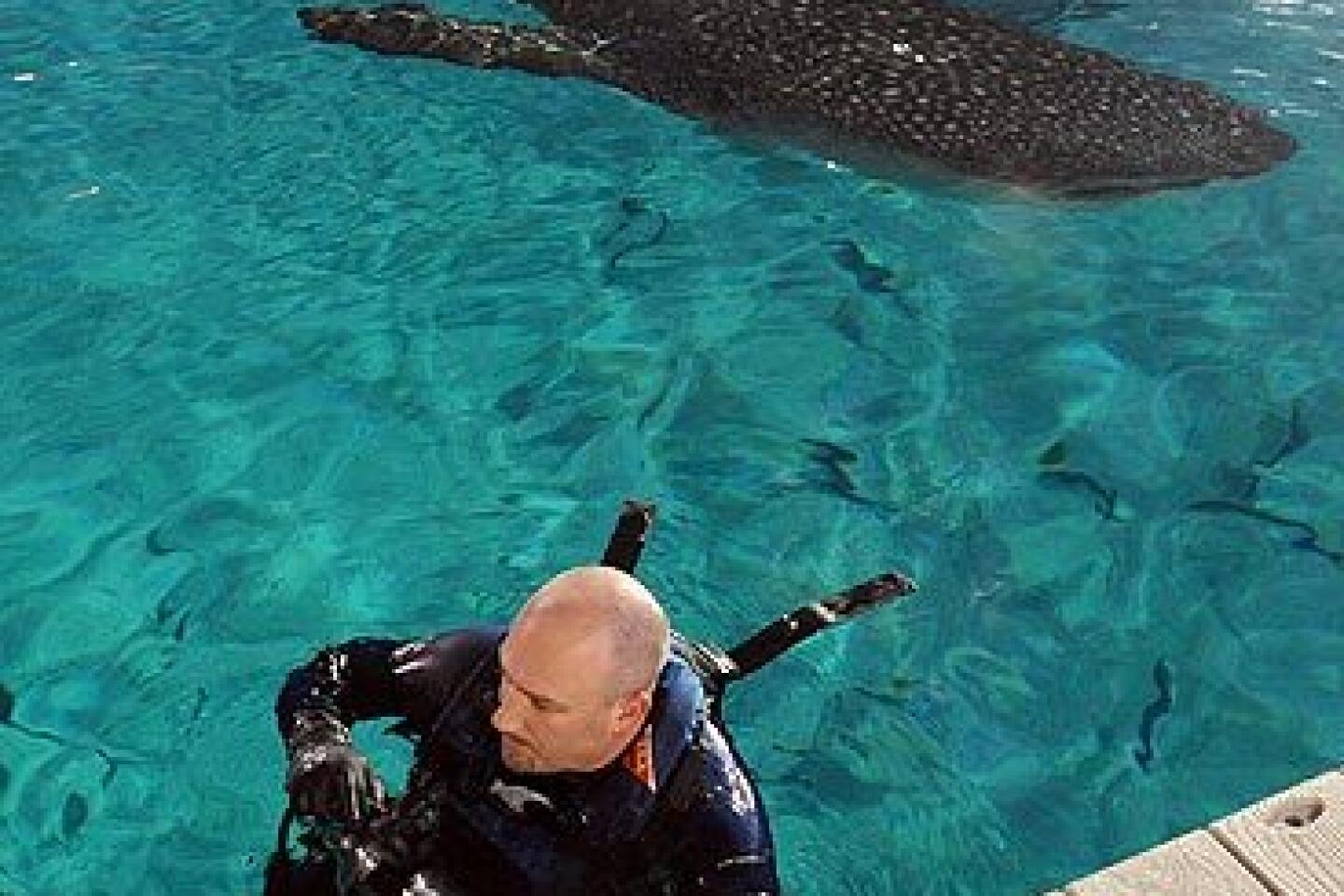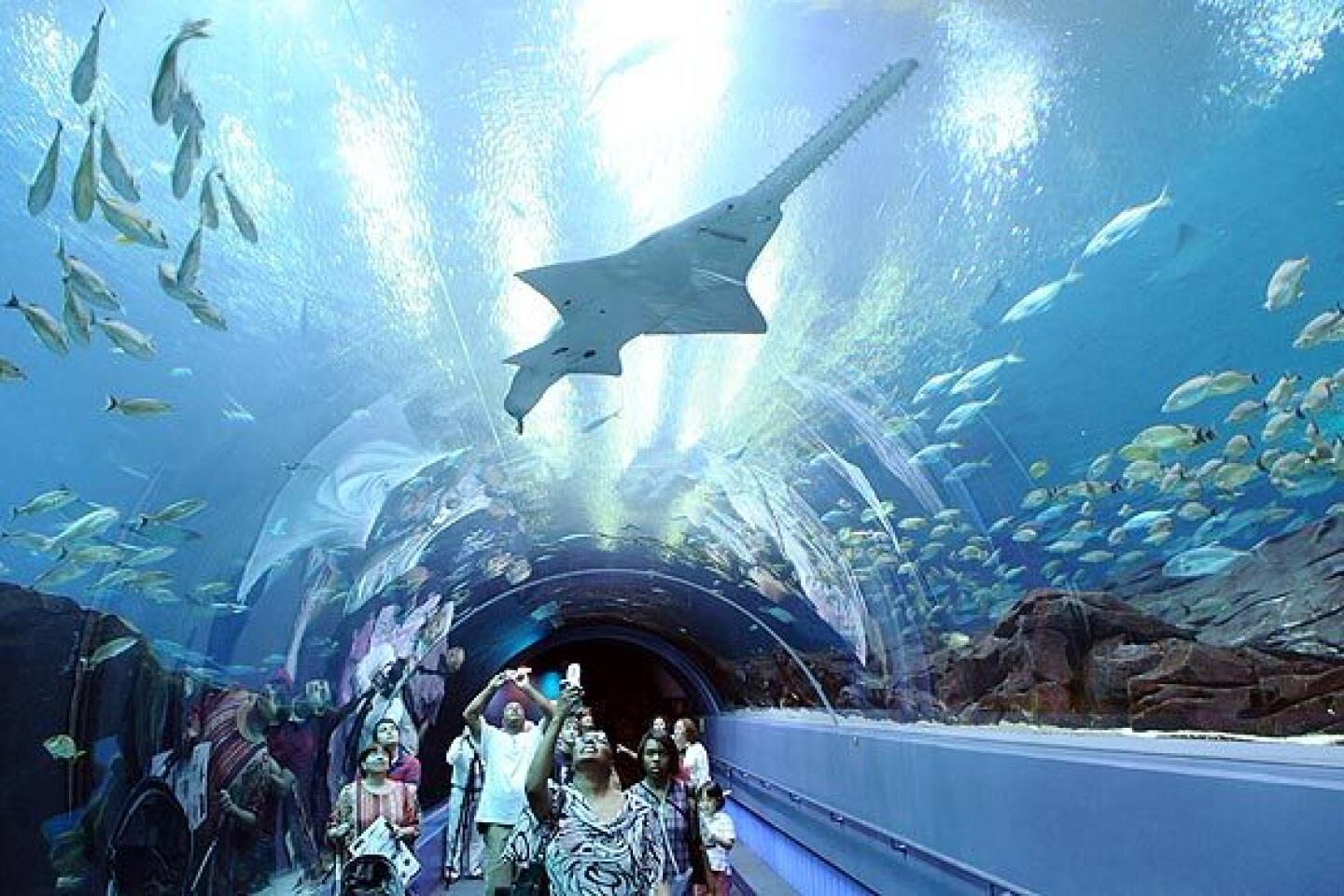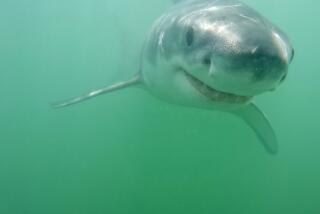Swimming with whale sharks at the Georgia Aquarium
Atlanta
Vikas Chinnan stood over a tank at the world’s largest aquarium, peering down at the world’s largest fish species. He was wondering what it would be like to jump in and frolic beside the whale sharks.
The creature approached, eerily quiet. It was longer than a Ford Expedition, impossibly elegant as it banked into a turn at the tank’s edge, flexing its gray, massive, mottled form into a parabola of living flesh.
“Oh man,” muttered Chinnan, 32, one of eight divers who had paid $290 for the privilege. “I hope they fill up our [air] tanks, because I’m going to be breathing hard.”
Whale sharks are as harmless as they are imposing, preferring plankton to people. But with the Georgia Aquarium launching its “Swim With Gentle Giants” program this month -- allowing a dozen swimmers and divers per day to enter the sharks’ habitat -- marine experts fear it is the humans who could pose a threat.
Much of the trepidation has to do with the 2 1/2 -year-old aquarium’s track record with whale sharks. Last year, two died for reasons that baffled staffers. Today, the “best hypothesis,” according to spokeswoman Meghann Gibbons, is that they reacted poorly to a chemical treatment used to combat parasites.
Jean-Michel Cousteau -- son of famed underwater explorer Jacques Cousteau -- was critical of the swim-with-the sharks program, given that the aquarium was not 100% sure why the animals died.
“They think maybe those sharks died because of some chemical treatment,” said Cousteau, founder of the nonprofit Ocean Futures Society in Santa Barbara. “I certainly don’t think there’s something to learn from someone swimming with a whale shark.”
George Burgess, director of the Florida Program for Shark Research at the Florida Museum of Natural History in Gainesville, agreed. The whale sharks, which roam hundreds of miles in the wild, already are stressed by their confinement, he said. And they are likely to be harmed further by close proximity to humans -- and by potential exposure to germs exotic to them.
“It’d be the equivalent of you being in a bedroom for the rest of your life after having had the ability to walk around freely,” Burgess said. “And then having 20 people come join you in your personal space every so often.”
The Georgia Aquarium is not the only one is the U.S. to offer visitor diving programs. But it is the only one outside of Asia to attempt to keep whale sharks, a little-understood animal that can grow as long as 60 feet. The controversy over the swim program has magnified a tension inherent in many big-ticket aquariums, which have proliferated around the globe in recent decades.
Though they typically promise to bolster marine education and advocacy, they also are entertainment venues competing for tourist dollars. Another world-class aquarium, in Chattanooga, Tenn., is only a two-hour drive from Atlanta.
Staffers at the Georgia Aquarium have defended the program. The four sharks kept in captivity, they said, are loosely monitored. Bruce Carlson, the chief science officer, is confident they will coexist with the daily stream of visitors.
“If we’re wrong and these animals look like they’re having negative reactions, we’ll pull the program,” he said.
Spokesman Dave Santucci noted that the fish were already used to people: Last year, he said, humans made about 5,000 trips into the tank for maintenance.
Santucci also noted that the aquarium was funding significant whale shark research projects in Mexico. The goal in Atlanta, he said, is to turn visitors into lifelong advocates for threatened ocean creatures.
“It’s one thing to come down here and see them through the glass,” he said, “and it’s another to get in the water and experience them in their environment.”
Chinnan and seven other certified scuba divers were in a small classroom recently far from the aquarium’s crowds, getting a briefing from lead dive master Edward Ryan.
The genial Ryan, who formerly ran the dive program at DisneyWorld’s Epcot Center, told them to keep a five-foot distance from the whale sharks and the thousands of other fish -- spotted wobbegongs and leopard sharks, guitarfish and trevally -- in the 6.3-million-gallon tank. He exhorted the group to follow instructions from the three staffers who would be diving with them, and to stay close together “so that we don’t stress the animals,” he said. “That’s the whole key.”
Moments later, the divers were crawling down a ladder and into the tank. They swam in a group beside an acrylic viewing tunnel packed with tourists. Lisa Davis, 37, snapped pictures as her fiance, Aaron Douglas of Santa Monica, waved from inside the tank. Someone snapped a photo of the couple: one of them dry, the other submerged, standing nearly beside each other.
“I don’t scuba, so it’s awesome for us to be able to participate with him like this,” Davis said.
A few minutes later, the divers had moved in front of a massive window, where visitors gawked at them as if they were another school of snapper. A diver named Kevin Chung broke into a flailing aquatic break-dance. A giant grouper that bore a strong resemblance to Don Rickles hung around.
The group posed for an underwater videographer, who would edit the experience into a $50 commemorative DVD. One of the whale sharks ventured close by, then cruised away, part of its incessant figure-eight ritual of confinement.
After the dive, Tracy Eden, 46, called it “amazing.”
“I think this gives people a different appreciation for the ocean,” he said.
A dripping-wet Chinnan added: “You’re always on the other side looking in, right?
“I’ve been here 10 times and every time I was like, I wish I could just jump in.”
In August, the aquarium may court more controversy when it begins building a $110-million dolphin exhibit. It’s the kind typically opposed by activists like Cousteau, who say such confinement is particularly cruel to marine mammals whose world is defined by acoustics.
Gibbons, the aquarium spokeswoman, would not say if a swim-dive program for dolphins was part of the plan. “The specifics are still being worked out,” she said.
More to Read
Sign up for The Wild
We’ll help you find the best places to hike, bike and run, as well as the perfect silent spots for meditation and yoga.
You may occasionally receive promotional content from the Los Angeles Times.
